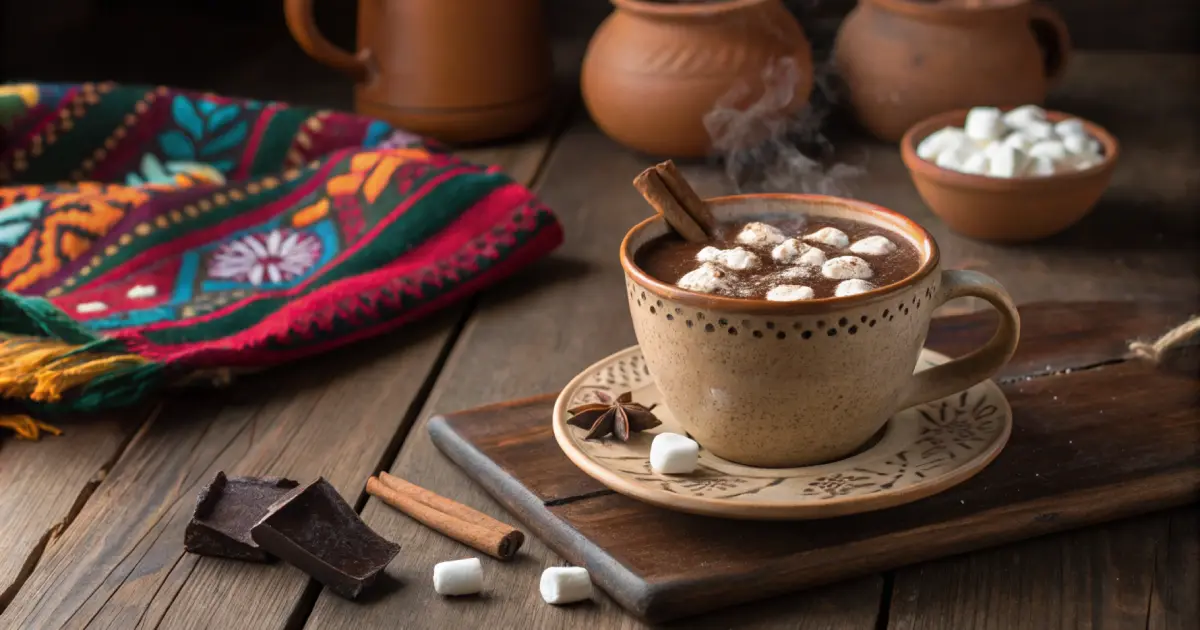Mexican hot chocolate isn’t just a warm drink—it’s an experience. This blend of rich
Mexican hot chocolate is not just a drink—it’s a rich cultural tradition. This warm, frothy beverage combines the earthy flavors of cacao with aromatic spices like cinnamon and chili. Unlike its sweeter, milder counterparts, it delivers bold flavors that awaken your senses and warm your heart. Whether you’re enjoying it on a chilly evening or sharing it during festive celebrations, this drink offers comfort and connection.
In this guide, we’ll explore every detail about Mexican hot chocolate, from its ancient origins to its modern variations. You’ll learn how to make it at home, discover its health benefits, and find out how to pair it with the perfect treats. By the end, you’ll be ready to create your own cup of this magical beverage and share it with loved ones.
Introduction
What Is Mexican Hot Chocolate?
Mexican hot chocolate stands apart from the cocoa you might be used to. It features chocolate that’s less processed and packed with authentic flavors. Made from cacao, sugar, and cinnamon, Mexican chocolate is often sold in round disks. When melted into warm milk or water, it creates a drink that’s smooth, earthy, and slightly spiced.
But Mexican hot chocolate isn’t just about the taste—it’s also about tradition. Families often prepare and share it during holidays or special gatherings. The act of whisking it with a molinillo (a traditional wooden whisk) adds to its charm, creating a frothy texture that’s as inviting as the drink itself.
Origins and Cultural Significance
The history of Mexican hot chocolate begins in ancient Mesoamerica, where cacao played a central role in the lives of the Mayans and Aztecs. They used cacao to create xocolatl, a frothy, unsweetened drink mixed with spices like chili. This beverage symbolized strength and vitality, and it was often consumed during ceremonies or by warriors preparing for battle.
After the Spanish conquest, cacao traveled to Europe, where sugar and milk were added to cater to European tastes. However, in Mexico, the drink retained its traditional elements. Today, Mexican hot chocolate continues to be a symbol of heritage, often prepared with love and shared with family and friends.
Ingredients and Unique Flavors
Core Ingredients of Mexican Hot Chocolate
The key to authentic Mexican hot chocolate lies in its ingredients. Mexican chocolate is at the heart of the recipe. Unlike sweetened cocoa powders, these chocolate disks are minimally processed, retaining the bold, earthy flavors of cacao. They are typically infused with cinnamon and unrefined sugar, giving the chocolate a coarse texture and a rich taste.
Other essential ingredients include milk (or water for a lighter version), vanilla, and spices like chili powder or cayenne. These elements come together to create a drink that’s flavorful and deeply satisfying.
Traditional Spices and Their Importance
Spices are what make Mexican hot chocolate unique. Cinnamon brings a sweet, woody aroma that balances the bitterness of the cacao. Chili adds a subtle kick, harkening back to its Aztec roots when heat symbolized vitality and strength. Vanilla, often used in its purest form, softens the spices and enhances the drink’s overall harmony.
Sweet and Spicy: A Perfect Balance
Mexican hot chocolate strikes the perfect balance between sweet and spicy. The natural sweetness of the chocolate and sugar contrasts beautifully with the warmth of the spices. This dynamic makes it an ideal drink for pairing with desserts like pan dulce or churros, creating a memorable culinary experience.
For more fusion recipe ideas, check out A Tasty Recipes.

How to Make Authentic Mexican Hot Chocolate
Essential Tools and Ingredients
Making this drink at home is easier than you think. The key tools include a saucepan, a whisk, or a molinillo for that traditional frothy texture. You’ll also need high-quality Mexican chocolate disks, milk (or a plant-based alternative), and spices like cinnamon and chili powder.
Step-by-Step Recipe
- Warm the Milk: Heat two cups of milk in a saucepan over medium heat. Stir it occasionally to ensure it doesn’t scorch. If you prefer a dairy-free option, almond or oat milk works wonderfully.
- Add the Chocolate: Break two ounces of Mexican chocolate into smaller pieces and add them to the warm milk. Stir until the chocolate has completely melted.
- Whisk Until Frothy: Use a whisk or molinillo to vigorously stir the mixture. This step creates the signature frothy texture that makes Mexican hot chocolate so special.
- Serve with Toppings: Pour the drink into a mug and add your favorite toppings. Options include whipped cream, marshmallows, or a sprinkle of cinnamon.
Tips for Customizing Flavors
Mexican hot chocolate is incredibly versatile. For a richer drink, add a splash of heavy cream. If you love a bit of spice, increase the chili powder or add a pinch of cayenne. For a festive twist, try stirring in peppermint extract or garnishing with crushed candy canes.
The History of Mexican Hot Chocolate
From Ancient Mesoamerica to Modern Kitchens
The story of Mexican hot chocolate begins thousands of years ago in ancient Mesoamerica. The Mayans and Aztecs considered cacao sacred, believing it was a gift from the gods. They used cacao beans to create a frothy drink mixed with water, chili, and other spices. This drink, called xocolatl, was served during ceremonies and consumed by warriors for strength.
After the Spanish arrived, cacao was introduced to Europe, where sugar and milk were added to sweeten the drink. In Mexico, however, traditional preparation methods persisted, preserving the deep cultural significance of our hot chocolate. Today, it remains a beloved part of celebrations and everyday life.
The Role of Cacao in Aztec and Mayan Culture
For the Aztecs and Mayans, cacao was more than food—it was wealth. They used it as currency and saw it as a status symbol. Warriors drank cacao for energy, and priests offered it during rituals. Even now, the legacy of cacao lives on in the comforting richness of Mexican hot chocolate.
For more traditional recipes inspired by ancient flavors, visit A Tasty Recipes.
Variations and Regional Takes
Champurrado: A Thickened Delight
One popular variation of Mexican hot chocolate is champurrado, a thicker and heartier drink. Made with masa harina (corn flour), champurrado is sweetened with piloncillo (unrefined cane sugar) and flavored with cinnamon and vanilla. This drink is often served during holidays and pairs beautifully with tamales.
Using Local Spices and Sweeteners
Mexican hot chocolate varies by region. In southern Mexico, you might find versions flavored with allspice or anise. Sweeteners like honey or agave are also common, adding a natural twist to the traditional recipe.
Fusion Recipes Featuring Mexican Hot Chocolate
Mexican hot chocolate has inspired countless fusion recipes, including spiced cupcakes, cookies, and even ice cream. These creative dishes showcase the drink’s signature flavors in new and exciting ways, introducing it to a broader audience.
Perfect Pairings and Serving Ideas
Traditional Mexican Treats to Serve With
this drink pairs beautifully with traditional Mexican treats like pan dulce, churros, or marranitos (gingerbread cookies). These sweet snacks enhance the warm, spiced flavors of the drink, making it perfect for celebrations or cozy nights in.
Creative Serving Suggestions
For an extra-special presentation, serve your drink in traditional clay mugs. Top it with marshmallows, whipped cream, or a drizzle of Mexican caramel (cajeta). You can also sprinkle a bit of chili powder on top for a gourmet touch.
Health Benefits of Mexican Hot Chocolate
Nutritional Benefits of Cacao
Cacao, the main ingredient in our hot chocolate, is packed with antioxidants. These help fight inflammation and support heart health. It’s also high in magnesium, which reduces stress and promotes relaxation.
Why Spices Are Good for You
The spices in Mexican hot chocolate, like cinnamon and chili, come with their own health benefits. Cinnamon can help regulate blood sugar, while chili boosts circulation and metabolism. Together, they create a drink that’s as nourishing as it is delicious.
FAQs About Mexican Hot Chocolate
What Makes this drink Different?
Mexican hot chocolate uses minimally processed chocolate disks spiced with cinnamon and chili, creating bold flavors and a frothy texture.
What Is Champurrado Made Of?
Champurrado is a thicker version of Mexican hot chocolate, made with masa harina, piloncillo, and milk or water.
What Is the Difference Between Hot Chocolate and Champurrado?
Hot chocolate is creamy and light, while champurrado is thicker and heartier due to the addition of masa harina.
Why Does Mexican Chocolate Taste Different?
Mexican chocolate has a coarse texture and is flavored with cinnamon and unrefined sugar, giving it a unique, rustic taste.
Final Thoughts and Conclusion
This hot chocolate is more than a beverage—it’s a sensory experience rooted in centuries of tradition. From its origins in ancient Mesoamerica to its modern variations, this rich, spiced drink continues to warm hearts and bring people together. Its combination of authentic cacao and aromatic spices makes it a standout among hot beverages, offering both comfort and complexity.
Whether you enjoy it as a cozy winter treat, a holiday tradition, or a fun dessert option, there’s no wrong way to savor Mexican hot chocolate. Its versatility allows for endless customization, from vegan versions to creative toppings that add a personal touch. Plus, the health benefits of cacao and spices mean you can indulge with less guilt.
So why not grab a molinillo, whip up a frothy cup, and pair it with your favorite Mexican treat? Whether it’s your first time trying it or you’ve been enjoying it for years, IT is a drink that never goes out of style. For more traditional recipes, explore related articles that showcase the rich flavors of Mexico.


4 thoughts on “Mexican Hot Chocolate – A Rich and Spicy Tradition”